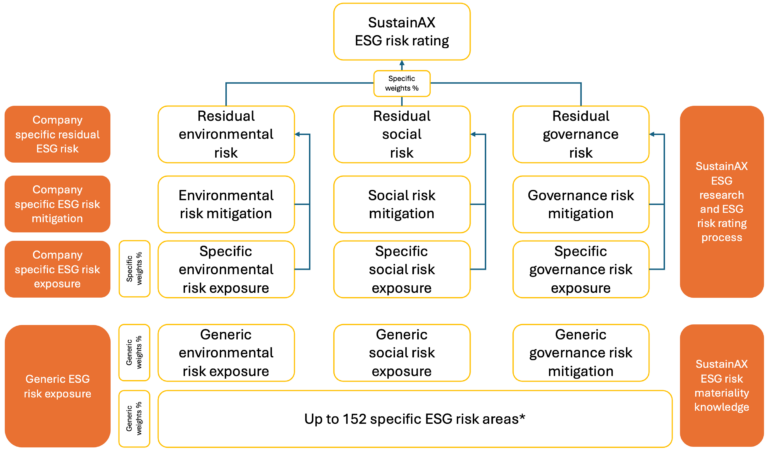sustainAX ESG rating processes
© sustainAX and www.sustainax.com, 2024. Unauthorized use and/or duplication of this material without express and written permission from this site’s author and/or owner is strictly prohibited. Excerpts and links may be used, provided that full and clear credit is given to sustainAX and www.sustainax.com with appropriate and specific direction to the original content.
1.ESG risk rating process
ESG risk research and ESG risk rating methodology
Our ESG risk research and rating process has the following steps that are for the most done in the described order, but that may well see iterations and jumping out of the outlined order during the process.
Our methodology has a set of mandatory elements to research that all our ESG analyst must follow.

The starting point – Understanding ESG risks
ESG Risk Materiality
Generic ESG risk
A crucial element of the ESG risk research process is to understand what kind of typical or “Generic ESG risk exposure” a certain corporate activity has and what are the most important ESG risks within that group. Activities are grouped in sectors.
The ESG risk materiality or “SustainAX ESG risk materiality knowledge“, is updated once a year and done by the ESG risk research team of SustainAX.
In the ESG reserarch process we spend time to understand the real activities of a company and from there we select the appropriate sector based on ESG risk materiality that is the most relevant.
Specific ESG risks
We then have the typical risks as a starting point. During the ESG research process we can adjust the ESG risk materiality to better fit the specific company by removing typical risks or adding overlays for other ESG risks that we find relevant, this gives us the “Company specific ESG risk exposure“.
The SustainAX ESG research and ESG risk rating process
Identifying the real ESG risk mitigation
By studying all the relevant company communication like annual reports, sustainability reports, policy documents, websites, etc. we look for elements that we as ESG risk analysts are contributing to ESG risk mitigation for the identified typical ESG risks. This gives us the “Company specific ESG risk mitigation“.
As specialists, we require more than basic narratives to be convinced that there is a real ESG risk mitigation happening. We look for details in description and often relevant KPIs are required before we consider it a real mitigation effort. KPIs without relevant narratives with details often carry little value in this part of the process.
We also consider other non-company information sources, particularly for the controversy search, where we are looking for ongoing controversies putting the company at financial risk.
Rating the residual ESG risk
As we assess the ESG risk mitigation value, we rate the ESG indicators that are related to each of the sub areas of the E, S and G dimensions. Per April 2024, we have in total 153 different indicators each addressing a small ESG risk domain. The rating reflects how much residual risk there is left after eventual mitigation effort for each of the relevant indicators and in total it gives the “Company specific residual ESG risk“. How many we take into account for a company depends on the sector and the company specific materiality adjustment.
Once this process finalised, our systems build the ESG, E, S and G ratings including the E, S and G weights. This is the “SustainAX ESG risk rating“.
Questionning the lacking ESG risk mitigation
During the process of identifying and assessing the residual ESG risks we also register the questions that we suggest should address the lacking ESG risk mitigation. These questions can be asked the company by our clients.
Concluding the ESG risk research and suggest ESG risk integration action
The final point is to write the summary of the remaining ESG risks. This is written manually by the ESG risk analyst and focus on the main remaining ESG risks.
We also suggest ESG risks that cannot be avoided to integrate in a process of ESG risk integration in investment decisions.
See ESG risk rating ranges for the companies we have ESG risk researched here:

